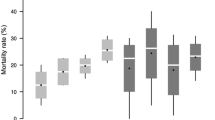Abstract
Both fecundities and egg hatchabilities were compared among three populations of Dastarcus helophoroides Fairmaire adults (Coleoptera: Bothrideridae) fed on three types of artificial diets (Diet of formula 1 composed of silkworm pupa powder, dried yeast powder, sucrose, peptone, egg yolk powder and poplar branch powder. Diet of formula 2 composed of silkworm pupa powder, dried yeast powder, sucrose, egg yolk powder, poplar branch powder, cricket powder, benzoic acid and distilled water. Diet of formula 3 composed of pine bark powder and Monochamus alternatus larva powder). for 90 days. The three diets showed no significant difference regarding the average number of eggs deposited by all D. helophoroides females (16622.3–23874.7); the average number of eggs per female (1278.6–1836.5); and the average number of eggs per female per day (14.2–20.4). The number of eggs one cluster contained mainly (82.06–82.66 %) lied in 1–100 eggs, and the average number of eggs per cluster ranged from 61.7 to 63.1. In the first 10-day period, the number of eggs deposited by all females fed on formula 1 was significantly larger than that on formula 3. The eggs deposited in the last four 10-day periods were more than in the former five 10-day periods, on formula 3. There were no significant differences in hatchability of total eggs among the three artificial diets, and the average corrected egg hatchability ranged from 82.85 to 84.78 %. No significant differences in the adult mortality and mean weight gain of D. helophoroides were found after feeding on three artificial diets. Our results suggest that D. helophoroides adults were not specialized on the diet, and the diet types might have little effect on fecundity and egg hatchability in D. helophoroides, as long as sufficient nutrition was supplied.


Similar content being viewed by others
References
Gao RT, Qin XX (1992) Colydiidae. In: Xiao GR (ed) Forest insects of China. China Forestry Publishing House, Beijing, pp 445–446
Ishii S (2004) Oviposition and development of Dastarcus helophoroides (Fairmaire) (D. longulus Sharp) in the laboratory. Appl For Sci 13:49–53
Jiang Y, Ma L, Zhang YN, Min J, Yang ZQ (2011) Effects of number of blocks and spatial size on induced spawning of Dastarcus helophoroide. J Northwest For Univ 39:83–85
Kaakeh W (2005) Longevity, fecundity, and fertility of the red palm weevil, Rynchophorus ferrugineus Olivier (Coleoptera: Curculionidae) on natural and artificial diets. Emir J Agric Sci 17:23–33
Lei Q, Cheng JF, Huang N, Li ML (2005) Artificial fodder ingredience for Dastarcus longulus adults. China Agri Sci Bull 21:259–261
Li JQ, Yang ZQ, Zhang YL, Mei ZX, Zhang YR, Wang XY (2009a) Biological control of Batocera horsfieldi (Coleoptera: Cerambycidae) by releasing its parasitoid Dastarcus helophoroides (Coleoptera: Bothrideridae). Sci Sil Sin 45:94–100
Li ML, Li YZ, Lei Q, Yang ZQ (2009b) Biocontrol of asian longhorned bettle larva by releasing eggs of Dastarcus helophoroides (Coleoptera: Bothrideridae). Sci Sil Sin 45:78–82
Miura K, Abe T, Nakashima Y, Urano T (2003) Field release of a parasitoid Dastarcus helophoroides (Fairmaire) (Coleoptera: Bothrideridae) on pine logs infested by Monochamus alternatus Hope (Coleoptera: Cerambycidae) and their dispersal. J Jpn For Soc 85(1):12–17
Ogura N, Tabata K, Wang WD (1999) Rearing of the colydiid beetle predator, Dastarcus helophoroides, on artificial diet. Biocontrol 44:291–299
Qin XX, Gao RT (1988) Biological characteristics and application of Dastarcus longulus. Entomol Knowl 25:109-102
Qin RH, Li ML, Zhang YN, Yang ZQ (2012) Screening for the release conditions of Dastarcus helophorides to control Monochamus alternatus. J Northwest Agri For Univ 40:92–96
Tang H, Yang ZQ, Zhang YN, Li GW (2007) Technical researches on distinguishing female and male alive adults of the main parasite of longhorn beetles, Dastarcus helophoroides (Coleoptera: Bothrideridae) without injuring. Acta Zootaxon Sin 32:649–654
Togashi K, Itabashi M (2005) Maternal size dependency of ovariole number in Dastarcus helophoroides (Coleoptera: Colydiidae). J For Res 10:373–376
Urano T (2003) Preliminary release experiments in laboratory and outdoor cages of Dastarcus helophoroides (Fairmaire) (Coleoptera: Bothrideridae) for biological control of Monochamus alternatus Hope (Coleoptera: Cerambycidae). Bull For For Prod Res Inst 2:255–262
Urano T (2006) Experimental release of adult Dastarcus helophoroides (Coleoptera: Bothrideridae) in a pine stand damaged by pine wilt disease: Effects on Monochamus alternatus (Coleoptera: Cerambycidae). Bull For For Prod Res Inst 5:257–263
Urano T (2010) Effects of host stage and number of feeding larvae on parasitism success and fitness in the coleopteran parasitoid, Dastarcus longulus Sharp (Coleoptera: Bothrideridae). Appl Entomol Zool 45:215–223
Wang WD, Ogura N (1999) Dastarcus helophorides growth in the laboratory. J Beijing For Univ 21:43–47
Wang XM, Ren GD, Ma F (1996) Taxonomic status and application prospect of Dastarcus helophorides. Acta Agri Boreal Occident Sin 5:75–78
Wang J, Fu FY, Situ CN (2010) Parasitism of Dastarcus helophoroide on Monochamus alternatus. For Pest Dis 29:38–39
Wei JR, Yang ZQ, Hao HL, Du JW (2008) (R)-(+)-limonene, kairomonee for Dastarcus helophoroides, a natural enemy of longhorned beetles. Agri For Entomol 10:1–8
Wei JR, Yang ZQ, Therese MP, Du JW (2009a) Parasitism and olfactory responses of Dastarcus helophoroides (Coleoptera: Bothrideridae) to different Cerambycid hosts. BioControl 54:733–742
Wei JR, Yang ZQ, Wang PY, Sun XG, Sun LG (2009b) Control of Massicus raddei (Blessig) (Coleoptera: Cerambycidae) by parasitic beetle Dastarcus helophoroides Sharp (Coleoptera: Bothrideridae). Chin J Biol Control 25:285–287
Yang ZQ (2004) Advance in bio-control researches of the important forest insect pests with natural enemies in China. Chin J Biol Control 20:221–227
Author information
Authors and Affiliations
Corresponding author
Additional information
Project funding: This study was supported by the National Natural Science Foundation of China (31300547), the Anhui Provincial Natural Science Foundation (1208085QC72), and the Anhui Provincial Science and Technology Program (10010302001).
The online version is available at http://www.springerlink.com
Corresponding editor: Chai Ruihai
Rights and permissions
About this article
Cite this article
Li, Xj., Dong, Gp., Yang, L. et al. Fecundity and egg hatchability of Dastarcus helophoroides adults fed on different types of artificial diets. J. For. Res. 26, 219–224 (2015). https://doi.org/10.1007/s11676-015-0015-2
Received:
Accepted:
Published:
Issue Date:
DOI: https://doi.org/10.1007/s11676-015-0015-2




